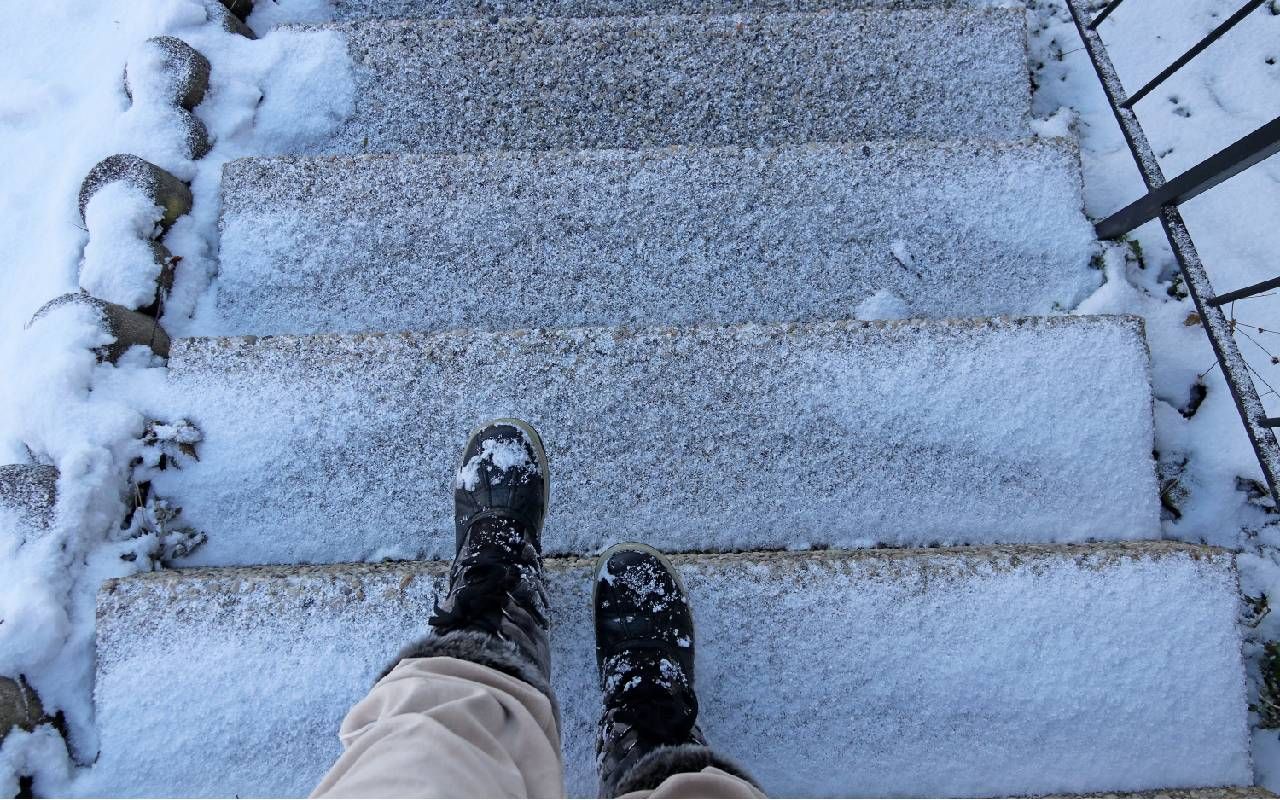Fight the Fear of Falling
Fear of falling stops individuals - even those with no physical impairment - from continuing with behaviors they are still able to do. Here are some ways to get past the fear.
After falling on the ice while walking her dog, Sandy Perry, of Madison, New Hampshire, broke her right femur. Following surgery and three months of intense physical therapy, she still couldn't walk and was afraid to leave the house. Homebound without her usual activities and interaction with friends, she became, as she says, "down in the dumps."

Falls Are No Fun
Sandy is not alone in experiencing the negative fallout from a fall. According to the Centers for Disease Control and Prevention, one in four Americans over age 65 falls annually. And 20% of these falls result in moderate to severe injuries and even death.
"Fear of falling is a product of experience."
In fact, fear of falling is the number one worry among older adults in the U.S., as reported by Elizabeth Walker Peterson, clinical professor in the Department of Occupational Therapy at the University of Illinois at Chicago. And it's not limited to someone who has already taken a tumble.
"Fear of falling is a product of experience," says Julie Honaker, Audiology Section Head and Director of the Vestibular and Balance Disorders Program at the Cleveland Clinic. "Yours or someone else's. Word of mouth from others who have sustained a fall can also instill fear."
Risk factors for falls have been well documented: poor vision and hearing, gait and balance problems, chronic illnesses like diabetes and multiple sclerosis that can lead to muscular changes, side effects of certain medications, and unsafe conditions in the home.
But there is one thing that many people do not consider a risk factor: the fear of falling or basiphobia. In layperson's terms, basiphobia is described as "the phobic reaction to standing or walking due to concerns about falling." Thinking twice before making that icy mailbox trip is common sense. Trouble starts when the fear of falling becomes so extreme that it sets in motion behaviors that can trigger a fall.
A Vicious Cycle
Why is fear of falling so dangerous? It stops individuals - even those with no physical impairment - from continuing with behaviors they are still able to do.
"What we know about fear of falling is that once someone is afraid of falling, they tend to do less and less, which increases their frailty."
A nervous anticipation of falling can lead to tightening the muscles or "stiffening" behavior. These attempts to control posture and movement limit your range of motion and change how you navigate your environment.
"You don't want to be stiff because then you are less able to adjust to changes in the terrain and more likely to fall," says Kirsten Dorsey, National Program Administrator for the Matter of Balance Program on behalf of MaineHealth. "You want to be like a tree in the wind that can sway and remain upright."
"What we know about fear of falling is that once someone is afraid of falling, they tend to do less and less, which increases their frailty," adds Dorsey. "That increased frailty can often lead to bones and muscles getting weaker from not being active and so when you do need to move around, you are more likely to fall."
Fear of falling introduces a vicious cycle: lost confidence, limited activities, fewer social interactions, reduced strength and mobility and depression. And possibly ending in a fall that fear did not prevent.
Finding a Solution
Perry finally persuaded her daughter to sign up for Matter of Balance, a program that teaches strengthening exercises and fall prevention skills. Initially introduced in the 1990s by a team at Boston University's Roybal Center, it was first used in a clinical setting. But the cost proved prohibitive, and, as Dorsey says, "The program gathered dust."
Until 2006, when MaineHealth translated it to a community setting staffed by lay people. Now, the program is available throughout the United States. To find a Matter of Balance program near you, click here.
"Once you help people get over the fear of falling, so much opens up for them."
During the pandemic, the in-person program pivoted to being virtual with good results. Initial reports showed that there was no statistical difference between the outcomes of the in-person program and the virtual program, says Dorsey.
After participating in the eight Matter of Balance sessions, Perry could walk ten miles along the boardwalk on the Jersey Shore. "I hadn't been able to do that in years," she says. The program improves strength and balance and "teaches you to think about what you're doing and keep in tune with your body."
Matter of Balance is one of the country's most widely implemented evidence-based fall prevention programs, but it's not the only one. The National Council of Aging website lists other evidence-based programs, too.
Talk It Out
So, how can you help your friend or family member who is terrified of falling? The most important thing is encouraging them to talk to someone about this obsession. But realize that family members sometimes do more harm than good by discouraging their loved one's activities.
Although they come from a place of concern, constantly cautioning a parent or sibling can have the opposite effect. It can cause your family members to become more sedentary, more anxious and more depressed.
"I think people are hesitant to talk about fear of falling because they're afraid they might lose some independence," says Honaker. "But having a conversation with a member of the family or a medical provider can bring the fear out into the open before it becomes a real danger."
And it's essential to deal with that danger. "Once you help people get over the fear of falling, so much opens up for them," says Dorsey.
Self-Help Fixes
Even if you are not enrolled in a fall prevention program, there are things you can do on your own. Here are six things that can help you fight the fear of falling:
- Select shoes that are optimal for balance. The American Podiatric Medical Association suggests putting shoes on the 1-2-3 test.
- Stop avoiding activities: Start small with achievable goals to build confidence, i.e., walk through an uncrowded mall for about 15 minutes.
- If you have an assistive device like a cane or a walker, use it: Practice it when you do not think you will need it. Get comfortable with your club or walker to know how to use it when you trip or lose your balance.
- Walk at your average speed: While fast walking isn't advised, walking too slowly could lead to a fall. Standing longer on one leg, even briefly, can cause instability.
- Think twice before reaching out for something: Trying to grab a piece of furniture to steady yourself can throw you off balance.
- Consider a combination of Cognitive Behavioral Therapy (CBT) and an exercise program: It combines talk therapy with physical interventions.


